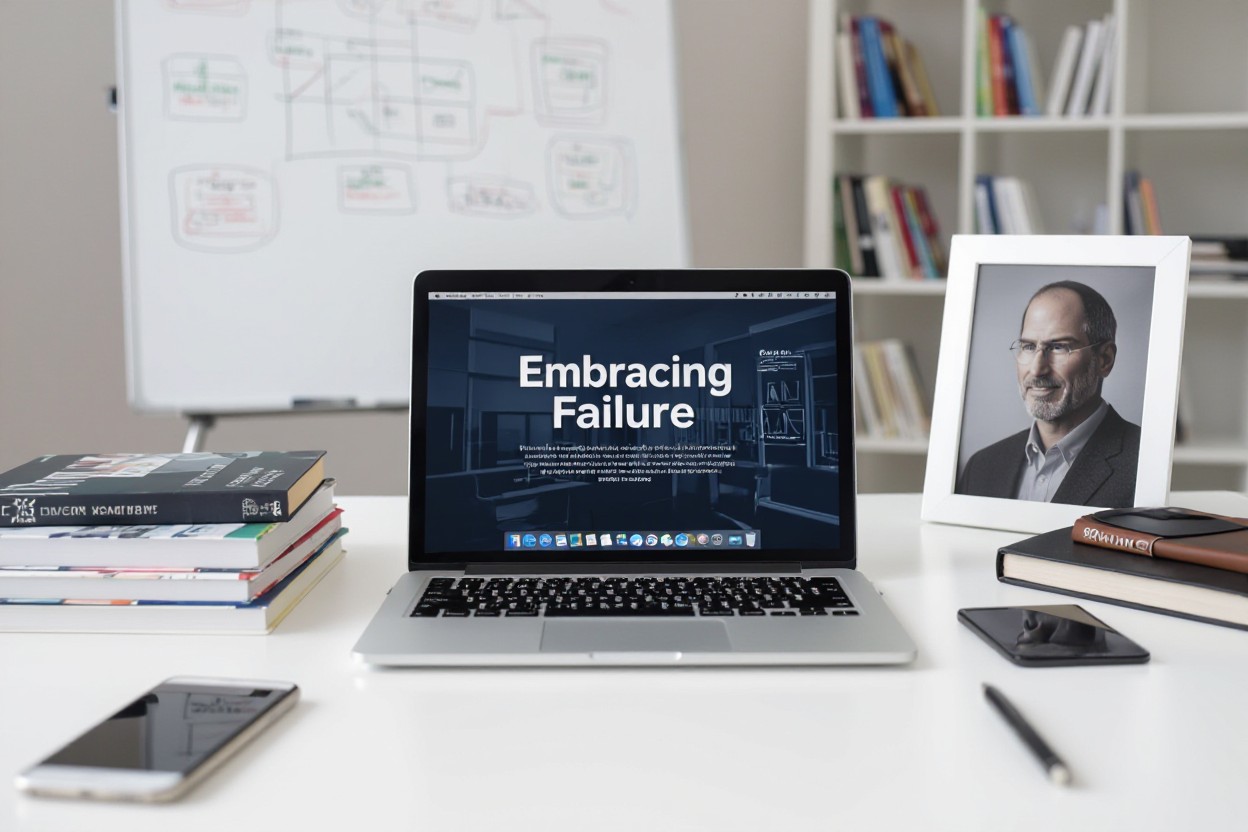Jobs often spoke about failure, but many of his insights remain overlooked in popular discourse. As someone deeply interested in innovation, I find his lesser-known quotes reveal a profound understanding of how setbacks fuel success. If you want to truly grasp the role failure plays in achieving your goals, exploring these hidden gems offers a new perspective. I invite you to discover what Steve Jobs really said about failure and how embracing it can transform your approach to challenges in both life and work.

Unmasking Steve Jobs: The Man Behind the Curtain
Steve Jobs was more than a visionary; he was a complex individual shaped by unique experiences and relentless drive. Beyond the public persona, his personal journey reveals a mix of passion, stubbornness, and an acute sense of design and functionality. To grasp his views on failure, understanding the layers beneath the legend helps, showing how setbacks fueled his eventual successes.
Early Years: A Formative Influence on Perspective
Growing up in a modest Silicon Valley household, Jobs’ early experiences with adoption and a non-traditional family structure instilled in him a sense of independence and resilience. His fascination with electronics and calligraphy, initially seeming unrelated, later influenced his attention to product aesthetics and user experience. These eclectic influences laid the foundation for a perspective that valued creativity amid uncertainty, shaping how he later approached failure as a tool for growth.
The Rise of Apple: Embracing Risk and Innovation
Jobs’ co-founding of Apple in 1976 marked the start of a bold journey where innovation met significant risk. Introducing the Apple I for $666.66 was only the beginning; the launch of the Macintosh in 1984 showcased his willingness to bet on untested technology and user-friendly interfaces. His approach treated failure not as defeat but as feedback, fostering an environment where pushing boundaries became the norm despite the high stakes.
The drive to revolutionize computing led Jobs to prioritize simplicity and elegance, often clashing with industry norms. He believed real innovation demanded not just technical breakthroughs but daring design choices that challenged consumer expectations. The early failures—like the Apple III recall and initial lukewarm reception of the Macintosh—didn’t deter him but instead sharpened his focus on refining products. This iterative mindset became a hallmark of his leadership, where setbacks served as springboards rather than stumbling blocks, illustrating how embracing failure elevated Apple’s groundbreaking advancements.
Wisdom in the Shadows: Lesser-Known Quotes on Failure
Steve Jobs’ commentary on failure often gets distilled into a few famous lines, but lurking beneath those are quotes that reveal a deeper perspective. One such insight is how he framed failure not simply as a setback but as a hidden compass directing innovation. Jobs once remarked that “Sometimes when you innovate, you make mistakes. It is best to admit them quickly and get on with improving your other innovations.” That attitude shows a nimble mindset, treating failure less as an end point and more as an iterative process necessary to creative breakthroughs.
Insights That Challenge Conventional Thinking
Jobs’ lesser-known reflections often undermine the fear-centric approach to failure prevalent in the corporate world. He viewed failure as a positive event: an experimental proof-point, rather than a blemish on one’s record. His statement, “You can’t connect the dots looking forward; you can only connect them looking backwards,” challenges the idea that failure can be predicted or always avoided. Instead, failure must be embraced as a natural, even necessary, overlay to future success.
The Broader Impact of Jobs’ Philosophy on Entrepreneurs
Entrepreneurs influenced by Jobs’ philosophy often adopt a radically different relationship with failure, seeing it less as a final verdict and more as a phase in growth. His nuanced views have encouraged a generation to embed resilience and agility into their ventures, catalyzing innovation cycles that tolerate risk and errors. For example, startups in Silicon Valley frequently cite Jobs’ approach as a reason they pivot quickly after setbacks, considering them as on-the-ground data rather than outright defeats.
Diving deeper, Jobs’ failure philosophy helped shift startup culture toward valuing rapid iteration and learning from mistakes, which you see vividly in methodologies like Agile and Lean Startup. Entrepreneurs inspired by Jobs understand that failure is a tested signal for recalibration — an necessary pulse check rather than a sign to fold. His legacy creates environments where transparency about faltering fosters solutions and fuels momentum, preventing stagnation often caused by fear of trying and failing.

Lessons from Missteps: How Failure Shaped Jobs’ Success
Steve Jobs’ path wasn’t a straight climb; it twisted through setbacks that redefined his strategy and vision. Rather than shunning failure, he used it as a catalyst, transforming each stumble into a stepping stone toward innovation. His ability to reflect critically on his missteps—not just to accept them—enabled him to discard ineffective ideas swiftly and double down on revolutionary ones. In my view, Jobs’ journey teaches that embracing failure with an investigative mindset can fuel the kind of resilience and insight that propels you beyond ordinary limits.
Specific Failures that Redefined His Approach
The infamous ousting from Apple in 1985 starkly reconfigured Jobs’ perspective. Losing control of the company he founded forced him to innovate outside his comfort zone, birthing NeXT and Pixar—ventures that honed his leadership and inventive instincts. This phase revealed how setbacks can become unexpected laboratories for growth, reshaping your approach to product design, management, and vision. Jobs’ comeback to Apple in 1997 marked a turning point where he fused lessons learned with renewed vigor, revolutionizing entire industries.
Transformative Moments: Learning from Disappointment
One particularly telling incident was the initial failure of the Apple Lisa, a project Jobs championed that flopped commercially. Instead of retreating, he used it to refine the Macintosh, making it more accessible and user-friendly. This disappointment wasn’t just a setback but a crucial pivot, sharpening his focus on creating technology that empowered users intuitively—a hallmark of his later success.
Diving deeper, the Lisa failure taught Jobs about market timing and user expectations, highlighting that innovation isn’t just about technical prowess but also about emotional connection with customers. He learned that excessive complexity alienates potential users, driving him to prioritize simplicity and practicality. This episode emphasizes how setbacks can serve as feedback loops, sharpening your instinct for what truly resonates and what doesn’t in the marketplace, which I believe is invaluable for sustaining long-term success.

The Greater Narrative: Failure as a Stepping Stone
Failure often acts less like a full stop and more like a comma in the story of innovation. Steve Jobs viewed setbacks not as roadblocks, but as vital pauses that allow for reassessment and reinvention. His career at Apple exemplifies how each misstep fueled a more refined vision, propelling groundbreaking products forward. Recognizing failure as an integral chapter rather than a dead end reshapes how you might approach obstacles on your own entrepreneurial journey.
The Role of Failure in the Legendary Apple Story
Apple’s near-collapse in the mid-1990s serves as a compelling example of failure’s transformative power. After being ousted from Apple, Jobs launched NeXT and acquired Pixar—ventures initially met with skepticism but ultimately pivotal in Apple’s revival. His return marked a turnaround powered by lessons learned through trial, error, and relentless refinement, culminating in the iMac and later the iPhone. That history underscores how failures are often embedded in the DNA of success.
Distilling Jobs’ Wisdom for Modern Entrepreneurs
One takeaway you can apply today is that Jobs saw failure not as the antithesis of success but as a feedback mechanism imperative for innovation. This mindset pushes you to iterate rapidly, embrace critique, and maintain boldness in the face of uncertainty. His approach encourages adopting a long-term view, where failures accumulate value by sharpening your vision and fueling resilience.
Diving deeper, Jobs’ emphasis on intuitive design and user experience often emerged from experimental failures that produced unexpected insights. He believed iteration bred intuition—each setback narrowed the possibilities until the most elegant solution surfaced. Today’s entrepreneurs can adopt this philosophy by welcoming early failures as research phases rather than catastrophes, transforming setbacks into strategic advantages.
Bridging Philosophy to Practice: Applying Jobs’ Insights Today
The real challenge lies in converting Steve Jobs’ profound reflections on failure into actionable strategies that meet today’s fast-evolving business landscape. By integrating the mindset that failure is a necessary component of experimentation, you can foster an agile environment. Companies like SpaceX demonstrate this, where iterative launches, each learning from prior missteps, propel technological progress. Embedding this iterative approach demands restructuring processes to value rapid prototyping and candid post-mortems, turning failure into a data-rich foundation rather than a deterrent.
Practical Takeaways for Current Business Challenges
Incorporate Jobs’ principle of embracing failure by encouraging teams to expose vulnerabilities early and learn quickly. For example, tech firms implement “fail fast, fail forward” methodologies, where short development cycles highlight flaws before costly scaling. Align your KPIs not only around success metrics but also on learning outcomes derived from setbacks. This shift transforms risk assessment from avoidance into managed experimentation, which is invaluable in navigating uncertainty, innovation bottlenecks, or market disruptions facing your organization.
Cultivating a Culture of Resilience Inspired by Jobs
Jobs saw resilience as a dynamic response to failure, a trait you must embed by explicitly valuing perseverance in your company culture. Google’s “20% time,” allowing employees to pursue side projects even amid official failure cases, exemplifies creating psychological safety to rebound creatively. By celebrating stories of calculated risks and rebound successes within your teams, resilience becomes ingrained rather than incidental, leading to sustained innovation under pressure.
Delving deeper, cultivating resilience inspired by Jobs means rewiring organizational norms to treat failure not as shameful loss but as an necessary asset in growth. It requires fostering transparent communication channels where teams share failure narratives openly, thus demystifying and destigmatizing setbacks. Leadership must model vulnerability and a growth mindset, signaling that resilience encompasses learning agility and emotional stamina. By institutionalizing reflection sessions, like Apple’s practice of dissecting product flops, you ensure adaptive feedback loops reinforce continuous improvement. This cultural transformation supports employees in approaching challenges proactively, driving innovation with confidence rather than fear.
Final Words
Presently, I find that Steve Jobs’ lesser-known remarks on failure offer profound insights into embracing setbacks as crucial steps toward innovation. He encouraged viewing failure not as defeat but as a learning experience that sharpens resilience and fosters creativity. By adopting this mindset, you can transform obstacles into opportunities to refine your vision and drive your success. I believe understanding these nuanced perspectives on failure can empower you to pursue your goals with confidence, knowing that mistakes are an integral part of the journey rather than the end of it.





Leave a comment